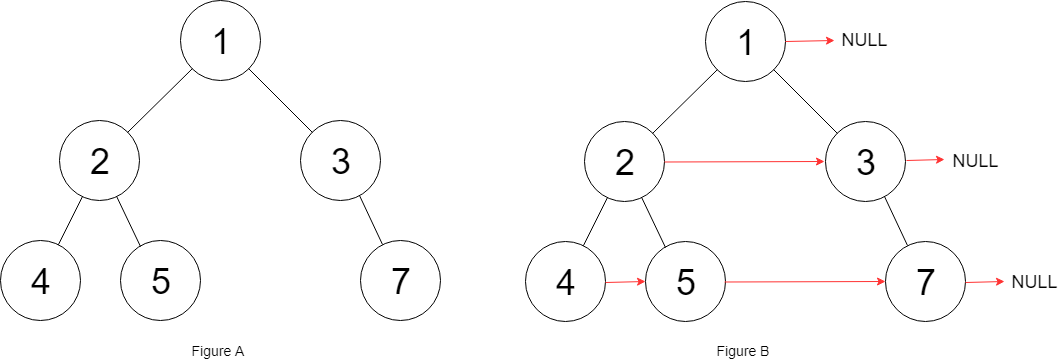[LeetCode] Populating Next Right Pointers in Each Node II 每个节点的右向指针之二
Given a binary tree
struct Node {
int val;
Node *left;
Node *right;
Node *next;
}
Populate each next pointer to point to its next right node. If there is no next right node, the next pointer should be set to NULL.
Initially, all next pointers are set to NULL.
Example:

Input: {"$id":"1","left":{"$id":"2","left":{"$id":"3","left":null,"next":null,"right":null,"val":4},"next":null,"right":{"$id":"4","left":null,"next":null,"right":null,"val":5},"val":2},"next":null,"right":{"$id":"5","left":null,"next":null,"right":{"$id":"6","left":null,"next":null,"right":null,"val":7},"val":3},"val":1}
Output: {"$id":"1","left":{"$id":"2","left":{"$id":"3","left":null,"next":{"$id":"4","left":null,"next":{"$id":"5","left":null,"next":null,"right":null,"val":7},"right":null,"val":5},"right":null,"val":4},"next":{"$id":"6","left":null,"next":null,"right":{"$ref":"5"},"val":3},"right":{"$ref":"4"},"val":2},"next":null,"right":{"$ref":"6"},"val":1}
Explanation: Given the above binary tree (Figure A), your function should populate each next pointer to point to its next right node, just like in Figure B.
Note:
- You may only use constant extra space.
- Recursive approach is fine, implicit stack space does not count as extra space for this problem.
这道是之前那道 Populating Next Right Pointers in Each Node 的延续,原本的完全二叉树的条件不再满足,但是整体的思路还是很相似,仍然有递归和非递归的解法。我们先来看递归的解法,这里由于子树有可能残缺,故需要平行扫描父节点同层的节点,找到他们的左右子节点。代码如下:
解法一:
class Solution {
public:
Node* connect(Node* root) {
if (!root) return NULL;
Node *p = root->next;
while (p) {
if (p->left) {
p = p->left;
break;
}
if (p->right) {
p = p->right;
break;
}
p = p->next;
}
if (root->right) root->right->next = p;
if (root->left) root->left->next = root->right ? root->right : p;
connect(root->right);
connect(root->left);
return root;
}
};
对于非递归的方法,我惊喜的发现之前的方法直接就能用,完全不需要做任何修改,算法思路可参见之前的博客 Populating Next Right Pointers in Each Node,代码如下:
解法二:
// Non-recursion, more than constant space
class Solution {
public:
Node* connect(Node* root) {
if (!root) return NULL;
queue<Node*> q;
q.push(root);
while (!q.empty()) {
int len = q.size();
for (int i = ; i < len; ++i) {
Node *t = q.front(); q.pop();
if (i < len - ) t->next = q.front();
if (t->left) q.push(t->left);
if (t->right) q.push(t->right);
}
}
return root;
}
};
虽然以上的两种方法都能通过OJ,但其实它们都不符合题目的要求,题目说只能使用constant space,可是OJ却没有写专门检测space使用情况的test,那么下面贴上constant space的解法,这个解法也是用的层序遍历,只不过没有使用queue了,我们建立一个dummy结点来指向每层的首结点的前一个结点,然后指针cur用来遍历这一层,我们实际上是遍历一层,然后连下一层的next,首先从根结点开始,如果左子结点存在,那么cur的next连上左子结点,然后cur指向其next指针;如果root的右子结点存在,那么cur的next连上右子结点,然后cur指向其next指针。此时root的左右子结点都连上了,此时root向右平移一位,指向其next指针,如果此时root不存在了,说明当前层已经遍历完了,我们重置cur为dummy结点,root此时为dummy->next,即下一层的首结点,然后dummy的next指针清空,或者也可以将cur的next指针清空,因为前面已经将cur赋值为dummy了。那么现在想一想,为什么要清空?因为我们用dummy的目的就是要指到下一行的首结点的位置即dummy->next,而一旦将root赋值为dummy->next了之后,这个dummy的使命就已经完成了,必须要断开,如果不断开的话,那么假设现在root是叶结点了,那么while循环还会执行,不会进入前两个if,然后root右移赋空之后,会进入最后一个if,之前没有断开dummy->next的话,那么root又指向之前的叶结点了,死循环诞生了,跪了。所以一定要记得清空哦,呵呵哒~
这里再来说下dummy结点是怎样指向每层的首结点的前一个结点的,过程是这样的,dummy是创建出来的一个新的结点,其目的是为了指向root结点的下一层的首结点的前一个,具体是这么做到的呢,主要是靠cur指针,首先cur指向dummy,然后cur再连上root下一层的首结点,这样dummy也就连上了。然后当root层遍历完了之后,root需要往下移动一层,这样dummy结点之后连接的位置就正好赋值给root,然后cur再指向dummy,dummy之后断开,这样又回到了初始状态,以此往复就可以都连上了,代码如下:
解法三:
// Non-recursion, constant space
class Solution {
public:
Node* connect(Node* root) {
Node *dummy = new Node(, NULL, NULL, NULL), *cur = dummy, *head = root;
while (root) {
if (root->left) {
cur->next = root->left;
cur = cur->next;
}
if (root->right) {
cur->next = root->right;
cur = cur->next;
}
root = root->next;
if (!root) {
cur = dummy;
root = dummy->next;
dummy->next = NULL;
}
}
return head;
}
};
类似题目:
Populating Next Right Pointers in Each Node
参考资料:
https://leetcode.com/problems/populating-next-right-pointers-in-each-node-ii/
LeetCode All in One 题目讲解汇总(持续更新中...)
[LeetCode] Populating Next Right Pointers in Each Node II 每个节点的右向指针之二的更多相关文章
- [LeetCode] 117. Populating Next Right Pointers in Each Node II 每个节点的右向指针 II
Follow up for problem "Populating Next Right Pointers in Each Node". What if the given tre ...
- 117 Populating Next Right Pointers in Each Node II 每个节点的右向指针 II
这是“每个节点的右向指针”问题的进阶.如果给定的树可以是任何二叉树,该怎么办?你以前的解决方案仍然有效吗?注意: 你只能使用恒定的空间.例如,给定以下二叉树, 1 / ...
- LeetCode: Populating Next Right Pointers in Each Node II 解题报告
Populating Next Right Pointers in Each Node IIFollow up for problem "Populating Next Right Poin ...
- LeetCode——Populating Next Right Pointers in Each Node II
Follow up for problem "Populating Next Right Pointers in Each Node". What if the given tre ...
- [leetcode]Populating Next Right Pointers in Each Node II @ Python
原题地址:https://oj.leetcode.com/problems/populating-next-right-pointers-in-each-node-ii/ 题意: Follow up ...
- LeetCode - Populating Next Right Pointers in Each Node II
题目: Follow up for problem "Populating Next Right Pointers in Each Node". What if the given ...
- [LeetCode] [LeetCode] Populating Next Right Pointers in Each Node II
Follow up for problem "Populating Next Right Pointers in Each Node". What if the given tre ...
- leetCode 116.Populating Next Right Pointers in Each Node (为节点填充右指针) 解题思路和方法
Given a binary tree struct TreeLinkNode { TreeLinkNode *left; TreeLinkNode *right; TreeLinkNode *nex ...
- [Leetcode] Populating next right pointer in each node 填充每个节点的右指针
Given a binary tree struct TreeLinkNode { TreeLinkNode *left; TreeLinkNode *right; TreeLinkNode *nex ...
随机推荐
- JavaScript知识点总结(命名规范,变量的作用域)
命名规范 有人说JavaScript的宽容性是这个语言最糟糕的方面之一.比如说想把2个数字加在一起,JavaScript会把其中一个数字解析成字符串,那么就会得到一个奇怪的字符串,而不是2个数字的和. ...
- 使用java代码关闭指定端口的程序-windows
转载请请在页首注明作者与出处 一:问题由史 今天遇到一个问题,就是在实现自动化灾备的时候,发现原有死掉的程序没有完全关闭,当然这都不是本文的重点,重点是这个时候,我得把它完全关闭,所以才有了这篇文章. ...
- Hive安装部署
目录 一. 安装Hive. 1 1. 选择CDH版本的... 1 2. 解压文件... 1 二. 配置Hive. 1 1. 配置环境变量 ...
- 怎样在Redis通过StackExchange.Redis 存储集合类型List
StackExchange 是由StackOverFlow出品, 是对Redis的.NET封装,被越来越多的.NET开发者使用在项目中. 绝大部分原先使用ServiceStack的开发者逐渐都转了过来 ...
- 一次页面从Jq到Vuejs+PartialView的迁徙
题外话 本篇分享不能帮助你入门vue,入门的文章也是无意义的,官方文档http://cn.vuejs.org/v2/guide/ 已经写的不能再清晰了.希望我们勇敢的主动地给自己创造实践的机会. 手里 ...
- Oracle用户被锁原因及办法
Oracle用户被锁原因及办法 在登陆时被告知test用户被锁 1.用dba角色的用户登陆,进行解锁,先设置具体时间格式,以便查看具体时间 SQL> alter session set nl ...
- redis开启远程访问
redis默认只允许本地访问,要使redis可以远程访问可以修改redis.conf 打开redis.conf文件在NETWORK部分有说明 ######################### ...
- Linux(十)___iptables防火墙
一.防火墙的作用 三.防火墙的分类 三.iptables基本语法: 表: 常用filter,nat用于地址映射转换. 配置文件: /etc/sysconfig/iptables 过滤表信息 . 查看i ...
- css3+jquery制作3d旋转相册
首先来看一下今天的炫酷效果: 首先分析一下这张图片: 1.每张图片都有倒影 2.这11张图片呈圆形均匀排列 3.可旋转,上下移动(当然这是效果做出来以后,图片是分析不出来的) 那下面就开始吧. 一.准 ...
- Sublime Text通过插件编译Sass为CSS及中文编译异常解决
虽然PostCSS才是未来,但是Sass成熟稳定,拥有一大波忠实的使用者,及开源项目,且最近Bootstrap 4 alpha也从Less转到Sass了.所以了解Sass还是非常有必要的. 基于快速开 ...
